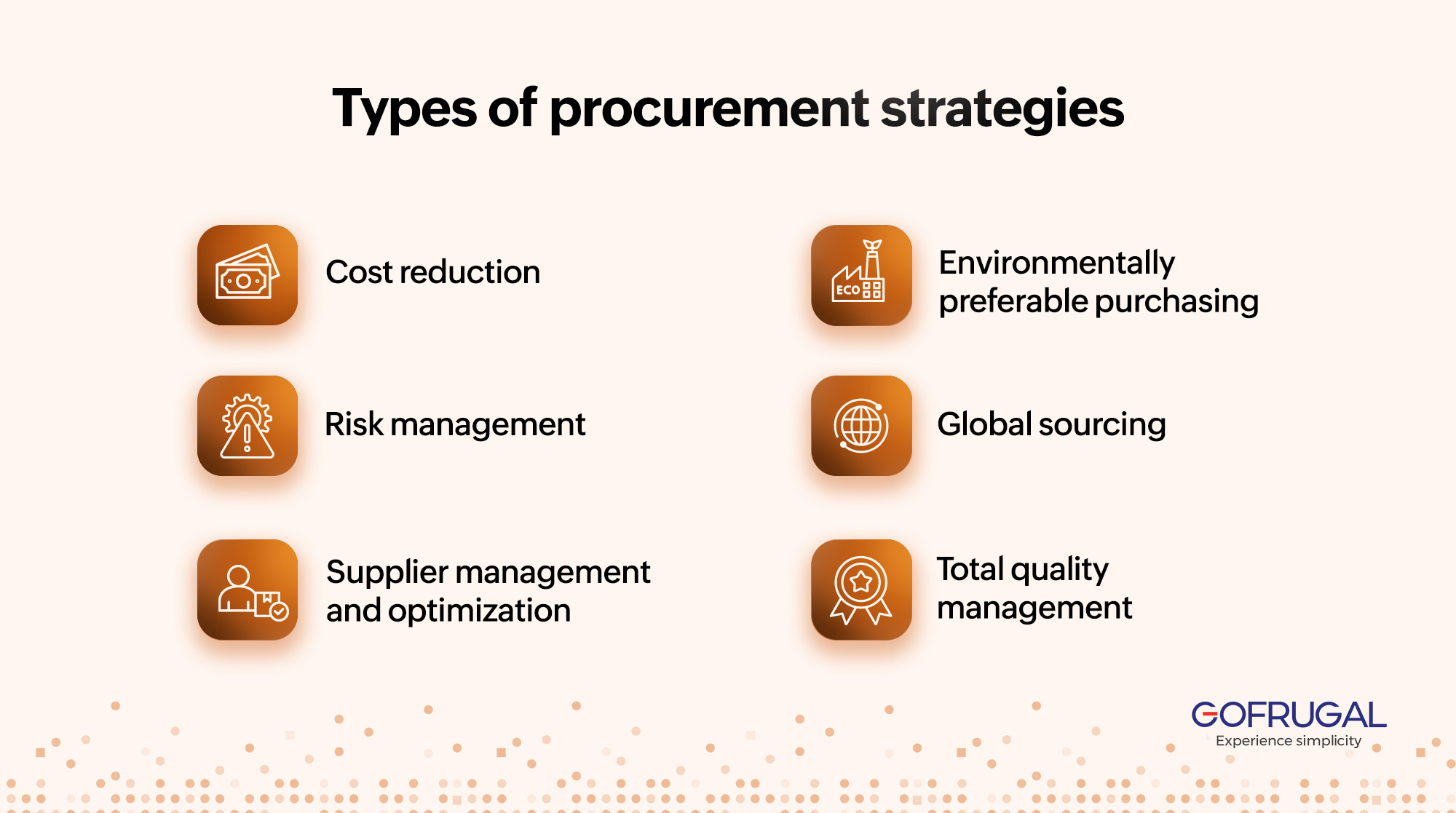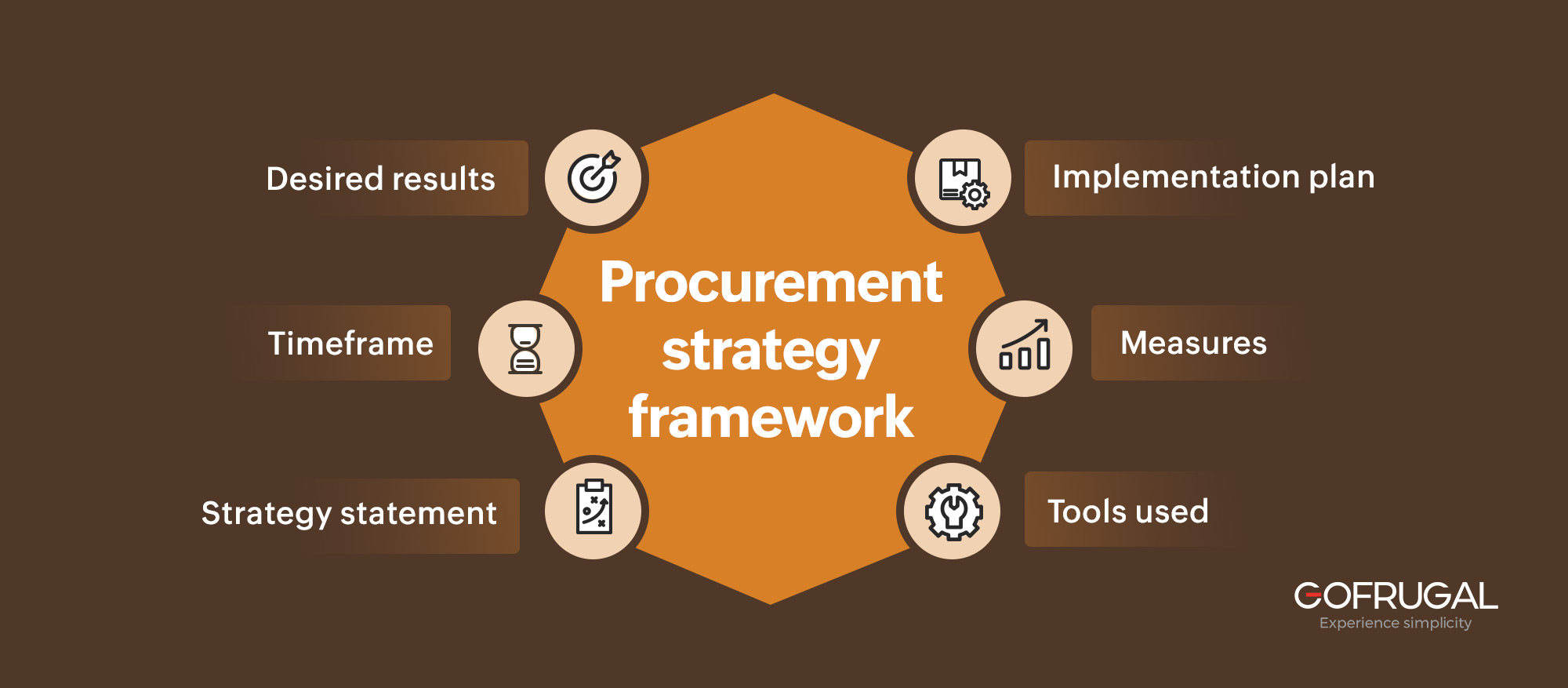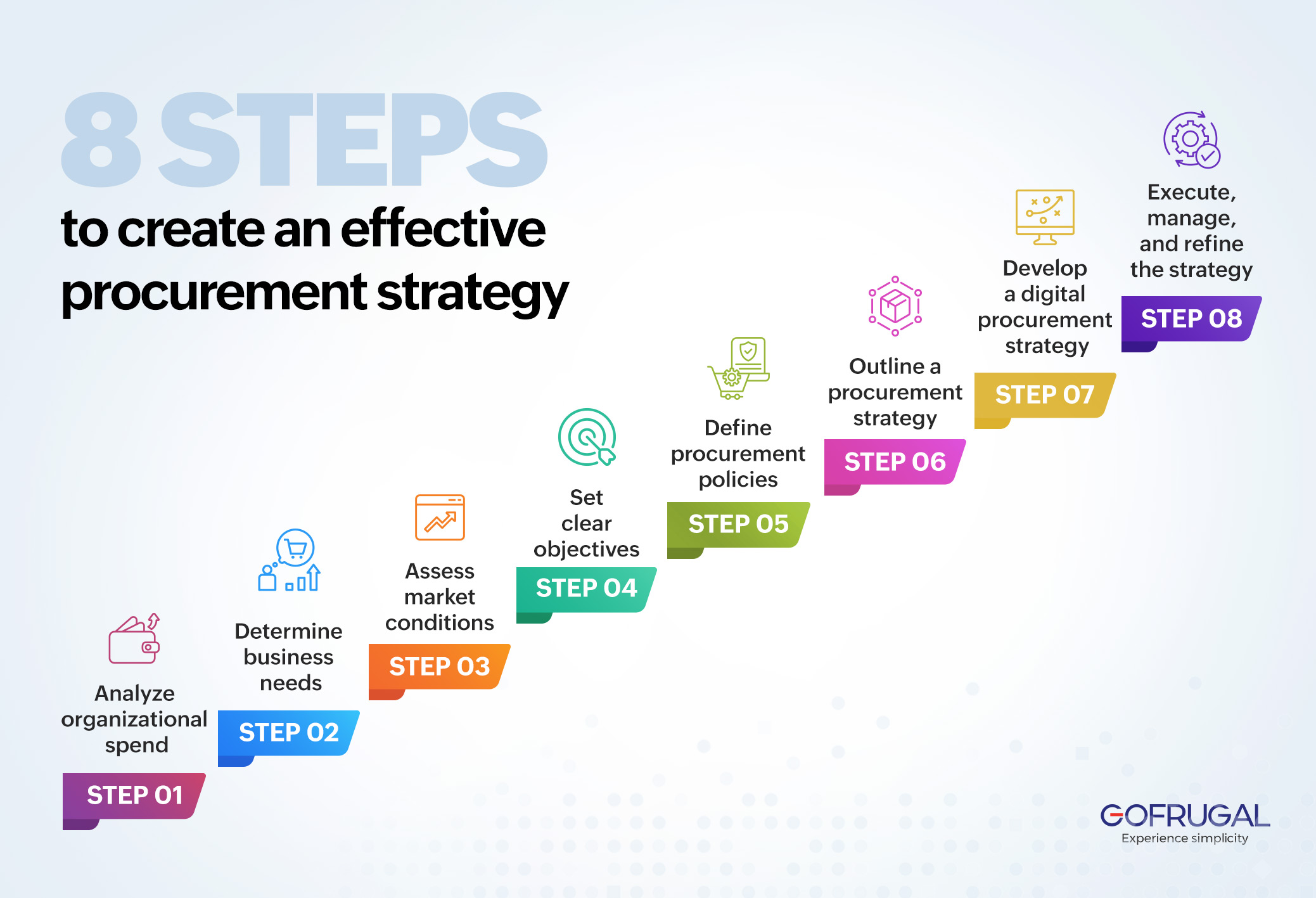Every company requires a well-defined strategy to facilitate the smooth execution of its roles and functions. In the world of goods production, one indispensable strategy is known as the procurement strategy. At its core, this strategy aims to guarantee the availability of all essential raw materials, equipment, and resources necessary for production.
The growth trajectory of a company significantly hinges upon the effective implementation of its procurement strategy, aligning it closely with the organization's overarching objectives. Here, you'll learn everything about the procurement strategy and how to execute it.
Contents
- What is a procurement strategy?
- Types of procurement strategies
- Procurement strategy framework
- 8 steps to create an effective procurement strategy
- Power of automation in procurement strategy
- How Gofrugal helps procurement management strategies
What is a procurement strategy?
A procurement strategy is a comprehensive plan aimed at efficiently acquiring necessary supplies from a select group of vendors who can provide quality goods, within specified timelines and purchase terms. It encompasses various factors such as purchase timelines, budget constraints, total cost of ownership (TCO), and potential risks.
Common objectives of procurement strategies include cost reduction, risk mitigation, and organic expansion. For instance, recent studies indicate that 78% of Chief Procurement Officers (CPOs) globally prioritize cost reduction as their primary procurement strategy.
Types of procurement strategies
There are different types of procurement strategies based on the nature of the business and the tasks involved in it.

- Cost reduction: Focuses on minimizing expenses associated with procurement processes, materials, and services.
- Risk management: Involves identifying, assessing, and mitigating potential risks in the procurement process, such as supply chain disruptions or quality issues.
- Supplier management and optimization: Emphasizes building strong relationships with suppliers, optimizing supplier selection, and ensuring reliable performance and delivery.
- Environmentally preferable purchasing: Aims at procuring environmentally friendly products and services, reducing environmental impact, and promoting sustainability.
- Global sourcing: Involves sourcing goods and services from international markets to leverage cost advantages, access specialized resources, and diversify the supply chain.
- Total quality management (TQM): Focuses on maintaining and improving product and service quality throughout the procurement process, ensuring customer satisfaction and continuous improvement.
Procurement strategy framework
Before getting started on the development of a procurement strategy, it is crucial to clearly understand what constitutes a well-defined strategy.

Strategy statement
Clearly articulate the basis and rationale behind the procurement strategy. This statement should outline the overarching goals, objectives, and guiding principles that drive procurement activities.
"What are the purpose and objectives?"
For example, the strategy statement could outline the goal of reducing procurement costs by 10% over the next fiscal year, with a focus on sustainable sourcing practices and strategic supplier partnerships.
Desired results
Define specific deliverables and outcomes that the procurement strategy aims to achieve. These results should be measurable, realistic, and aligned with organizational objectives.
"What do you aim to deliver?"
For example, one desired result could be to improve cash flow by reducing payment cycle time from 30 days to 25 days within the first six months of strategy implementation.
Timeframe
Establish clear deadlines and timelines for implementing the procurement strategy and achieving desired results. This ensures accountability and helps prioritize actions within set timeframes.
"How much time will it take to finish the deadline?"
For example, you might decide that implementing a new procurement software system must be completed within six months to streamline purchasing processes and improve data visibility.
Implementation plan
Outline the detailed steps and actions required to implement the procurement strategy effectively. This includes identifying key activities, assigning responsibilities, and coordinating efforts across relevant stakeholders.
"How will you be approaching and implementing the strategy?"
For example, conduct a spend analysis within the first quarter to identify high-cost categories and potential savings opportunities. Identify at least three cost-saving initiatives with a potential annual savings of 5% or more.
Measures
Define metrics and key performance indicators (KPIs) to evaluate the effectiveness and success of the procurement process. Crafting effective procurement KPIs requires alignment with your business goals and simplicity in tracking. Initially, the process might seem daunting, but by grasping their purpose, you can pinpoint KPIs that precisely cater to your requirements.
"How do you plan to measure the performances?"
For example, to get started, you can include the following KPI metrics for procurement process.
- Compliance rate: Measure this to ensure adherence to contractual terms and regulations, mitigating legal and financial risks.
- Supplier defect rate: Monitor this to maintain product or service quality standards and minimize operational disruptions.
- PO and invoice accuracy: Track this to prevent billing errors, streamline accounting processes, and maintain accurate financial records.
- Rate of emergency purchases: Evaluate this to identify inefficiencies in procurement planning and reduce reliance on costly last-minute acquisitions.
- Supplier lead time: Assess this to optimize inventory management and mitigate risks associated with supply chain delays.
- PO cycle time: Measure this to enhance procurement process efficiency and minimize delays in fulfilling orders.
- Vendor availability: Monitor this to ensure uninterrupted supply chain operations and mitigate risks of production delays.
- Cost per invoice and PO: Track this to identify opportunities for cost reduction and streamline administrative expenses.
- Spend under management (SUM): Evaluate this to gauge the extent of procurement control and strategic sourcing influence over organizational spending.
- Procurement ROI: Measure this to assess the overall effectiveness and value generated by procurement activities in relation to investment.
- Price competitiveness: Monitor this to ensure competitiveness in the market and maximize cost savings opportunities through strategic sourcing and negotiation strategies.
Tools used
Utilize various tools and methodologies to support the procurement strategy implementation and decision-making process. Examples include Total Cost of Ownership (TCO) analysis, SWOT analysis, Porter’s Five Forces analysis, Category Positioning Matrix, SCOPE Analysis, Fishbone Analysis, among others.
"What tools and software will you use to measure performances?"
For example, conduct a SWOT analysis for key suppliers to identify strengths, weaknesses, opportunities, and threats.
Metric: Identify at least two potential risks associated with each key supplier and develop mitigation strategies within three months.
8 steps to create an effective procurement strategy
An effective procurement strategy necessitates the alignment of business goals to ensure a seamless and efficient workflow.
Building a robust strategy is imperative to keep the procurement process on track and ensure the overall success of the business. Follow these eight steps to create the best procurement strategy.

1) Analyze organizational spend
Assessing current spending patterns provides valuable insights for shaping procurement strategies. Data from internal stakeholders and suppliers, coupled with tools like total cost of ownership (TCO), helps uncover hidden costs, and informs strategic decisions.
2) Determine business needs
Understanding organizational requirements is crucial for aligning procurement strategies with broader business objectives. Conducting fact-based analyses and challenging existing norms reveal opportunities for optimization and savings.
3) Assess market conditions
Evaluating external factors, such as supply markets and conditions, informs strategic procurement decisions. Techniques like Porter’s Five Forces analysis and SCOPE analysis aid in understanding market dynamics and supplier capabilities.
4) Set clear objectives
Establishing specific, measurable objectives based on identified business needs guides the procurement strategy. Prioritizing objectives according to their impact on the organization's bottom line facilitates focused action and resource allocation.
5) Define procurement policies
Developing clear procurement policies ensures consistency, transparency, and risk mitigation. Adapting existing policy templates and incorporating fair practices and remedies for violations fosters a conducive procurement environment.
6) Outline a procurement strategy
Drafting a comprehensive procurement strategy entails setting measurable goals and outlining tactics to achieve them. Goals should be time-bound and realistic, with a tactical plan detailing execution methods and innovative approaches.
7) Develop a digital procurement strategy
Leveraging data and insights, organizations should formulate a digital procurement strategy to optimize technology, processes, and talent. Prioritizing digital transformation enhances agility, efficiency, and strategic focus in procurement operations.
8) Execute, manage, and refine the strategy
Implementing the digital procurement strategy involves cross-functional collaboration and ongoing monitoring of progress. Tracking performance metrics and refining strategies based on feedback ensures continuous improvement and adaptation to changing business needs.
Here is the extra rewarding step that no one is telling you!
Implement procurement software
Manual procurement processes often lead to errors, delays, and increased costs. Utilizing software like Gofrugal ERP, which offers features for procurement management, streamlines processes, enhances productivity, and ensures compliance by automating tasks and identifying process gaps.
Power of automation in procurement strategy
A structured procurement strategy not only challenges the status quo but also identifies innovative approaches that drive cost savings and process efficiencies. Leveraging process automation tools to implement and monitor this strategy yields significant long-term benefits. These tools streamline complex procurement processes, minimizing risks and errors proactively.
Software that helps automate procurement management offers organizations a comprehensive solution to deploy their procurement strategy model, enhancing operational management from process automation to role-based user dashboards. Automation empowers organizations to engage in dynamic cost optimization processes by providing actionable insights and seamless integration with third-party data sources.
How Gofrugal helps procurement management strategies
Gofrugal ERP helps with procurement management in various aspects.
Centralized procurement
Providing a centralized platform for managing procurement activities allows businesses to streamline the entire procurement process from vendor selection to purchase order creation and inventory management.
Vendor management
With Gofrugal, businesses can easily manage vendor relationships, track vendor performance, and negotiate favorable terms and pricing. This helps optimize supplier relationships and ensure timely delivery of goods and services.
Inventory optimization
Optimize inventory levels with real-time visibility into stock levels, demand forecasting, and inventory replenishment. This ensures businesses have the right amount of inventory on hand to meet customer demand while minimizing excess stock and carrying costs.
Cost control
Businesses can control costs by identifying cost-saving opportunities, analyzing spending patterns, and enforcing procurement policies. This helps reduce maverick spending and maximizes savings across the procurement process.
Process automation
Gofrugal's procurement automation solutions redefine cash flow management by optimizing essential processes like purchase requisitions, approvals, and invoice processing. Recognizing that effective procurement profoundly influences cash flow, with businesses allocating roughly 30% of revenue daily, Gofrugal ensures resources are utilized efficiently to prevent overstocking and maximize ROI. By automating these critical workflows, businesses can shift focus from administrative tasks to strategic initiatives, leveraging streamlined processes for sustainable growth and enhanced profitability.
Analytics and reporting
Gofrugal provides advanced analytics and reporting capabilities that enable businesses to gain insights into procurement performance, identify areas for improvement, and make data-driven decisions. This helps optimize procurement strategies and drive continuous improvement.
The discussed procurement strategies have the potential to significantly enhance company performance when coupled with digital transformation. If you're seeking to automate your procurement strategy, consider exploring Gofrugal ERP for innovative solutions on the go.

